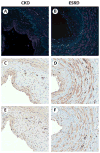Increased plasma chymase concentration and mast cell chymase expression in venous neointimal lesions of patients with CKD and ESRD
- PMID: 21781173
- PMCID: PMC3212616
- DOI: 10.1111/j.1525-139X.2011.00921.x
Increased plasma chymase concentration and mast cell chymase expression in venous neointimal lesions of patients with CKD and ESRD
Abstract
The underlying inflammatory component of chronic kidney disease may predispose blood vessels to intimal hyperplasia (IH), which is the primary cause of dialysis access failure. We hypothesize that vascular pathology and markers of IH formation are antecedent to arteriovenous (AV) fistula creation. Blood, cephalic, and basilic vein segments were collected from predialysis chronic kidney disease (CKD) patients with no previous AV access and patients with end-stage renal disease (ESRD). Immunohistochemistry was performed with antibodies against mast cell chymase, transforming growth factor-beta (TGF-β) and interleukin-6 (IL-6), which cause IH. Plasma chymase was measured by ELISA. IH was present in 91% of CKD and 75% of ESRD vein segments. Chymase was abundant in vessels with IH, with the greatest expression in intima and medial layers, and virtually absent in the controls. Chymase colocalized with TGF-β1 and IL-6. Plasma chymase concentration was elevated up to 33-fold in patients with CKD versus controls and was associated with increased chymase in vessels with IH. We show that chymase expression in vessels with IH corresponds with plasma chymase concentrations. As chymase inhibition attenuates IH in animal models, and we find chymase is highly expressed in IH lesions of patients with CKD and ESRD, we speculate that chymase inhibition could have therapeutic value in humans.
© 2011 Wiley Periodicals, Inc.
Figures



Similar articles
-
Effect of chymase inhibition on the arteriovenous fistula stenosis in dogs.J Am Soc Nephrol. 2005 Apr;16(4):1024-34. doi: 10.1681/ASN.2003121009. Epub 2005 Mar 2. J Am Soc Nephrol. 2005. PMID: 15744002
-
Inflammation, oxidation and venous neointimal hyperplasia precede vascular injury from AVF creation in CKD patients.J Vasc Access. 2012 Apr-Jun;13(2):168-74. doi: 10.5301/jva.5000024. J Vasc Access. 2012. PMID: 22020525 Free PMC article.
-
Severe venous neointimal hyperplasia prior to dialysis access surgery.Nephrol Dial Transplant. 2011 Jul;26(7):2264-70. doi: 10.1093/ndt/gfq733. Epub 2011 Jan 10. Nephrol Dial Transplant. 2011. PMID: 21220751 Free PMC article.
-
Vascular chymase: pathophysiological role and therapeutic potential of inhibition.Cardiovasc Res. 2004 Mar 1;61(4):653-62. doi: 10.1016/j.cardiores.2003.11.029. Cardiovasc Res. 2004. PMID: 14985062 Review.
-
Tissue-specific expression of mast cell granule serine proteinases and their role in inflammation in the lung and gut.Immunology. 2002 Apr;105(4):375-90. doi: 10.1046/j.1365-2567.2002.01375.x. Immunology. 2002. PMID: 11985658 Free PMC article. Review.
Cited by
-
Novel paradigms for dialysis vascular access: downstream vascular biology--is there a final common pathway?Clin J Am Soc Nephrol. 2013 Dec;8(12):2194-201. doi: 10.2215/CJN.03490413. Epub 2013 Aug 29. Clin J Am Soc Nephrol. 2013. PMID: 23990166 Free PMC article. Review.
-
Mast cells in human and experimental cardiometabolic diseases.Nat Rev Cardiol. 2015 Nov;12(11):643-58. doi: 10.1038/nrcardio.2015.117. Epub 2015 Aug 11. Nat Rev Cardiol. 2015. PMID: 26259935 Review.
-
Impact of Mast Cell Chymase on Renal Disease Progression.Curr Hypertens Rev. 2012 Feb 1;8(1):15-23. doi: 10.2174/157340212800505007. Curr Hypertens Rev. 2012. PMID: 23503162 Free PMC article.
-
Optimal hemodialysis vascular access in the elderly patient.Semin Dial. 2012 Nov-Dec;25(6):640-8. doi: 10.1111/sdi.12037. Semin Dial. 2012. PMID: 23173892 Free PMC article. Review.
-
Alpha-1 antitrypsin, a diagnostic and prognostic marker of vernal keratoconjunctivitis.J Clin Diagn Res. 2014 May;8(5):CC08-10. doi: 10.7860/JCDR/2014/6342.4362. Epub 2014 May 15. J Clin Diagn Res. 2014. PMID: 24995171 Free PMC article.
References
-
- Roy-Chaudhury P, Arend L, Zhang J, Krishnamoorthy M, Wang Y, Banerjee R, Samaha A, Munda R. Neointimal hyperplasia in early arteriovenous fistula failure. Am J Kidney Dis. 2007;50:782–790. - PubMed
-
- Roy-Chaudhury P, Kelly BS, Miller MA, Reaves A, Armstrong J, Nanayakkara N, Heffelfinger SC. Venous neointimal hyperplasia in polytetrafluoroethylene dialysis grafts. Kidney Int. 2001;59:2325–2334. - PubMed
-
- Beaulieu MC, Gabana C, Rose C, MacDonald PS, Clement J, Kiaii M. Stenosis at the area of transposition—an under-recognized complication of transposed brachiobasilic fistulas. J Vasc Access. 2007;8:268–274. - PubMed
-
- Quinn SF, Schuman ES, Hall L, Gross GF, Uchida BT, Standage BA, Rosch J, Ivancev K. Venous stenoses in patients who undergo hemodialysis: treatment with self-expandable endovascular stents. Radiology. 1992;183:499–504. - PubMed
-
- Vorwerk D, Guenther RW, Mann H, Bohndorf K, Keulers P, Alzen G, Sohn M, Kistler D. Venous stenosisocclusion in hemodialysis shunts: follow-up results of stent placement in 65 patients. Radiology. 1995;195:140–146. - PubMed
Publication types
MeSH terms
Substances
Grants and funding
LinkOut - more resources
Full Text Sources
Other Literature Sources
Medical
Research Materials

